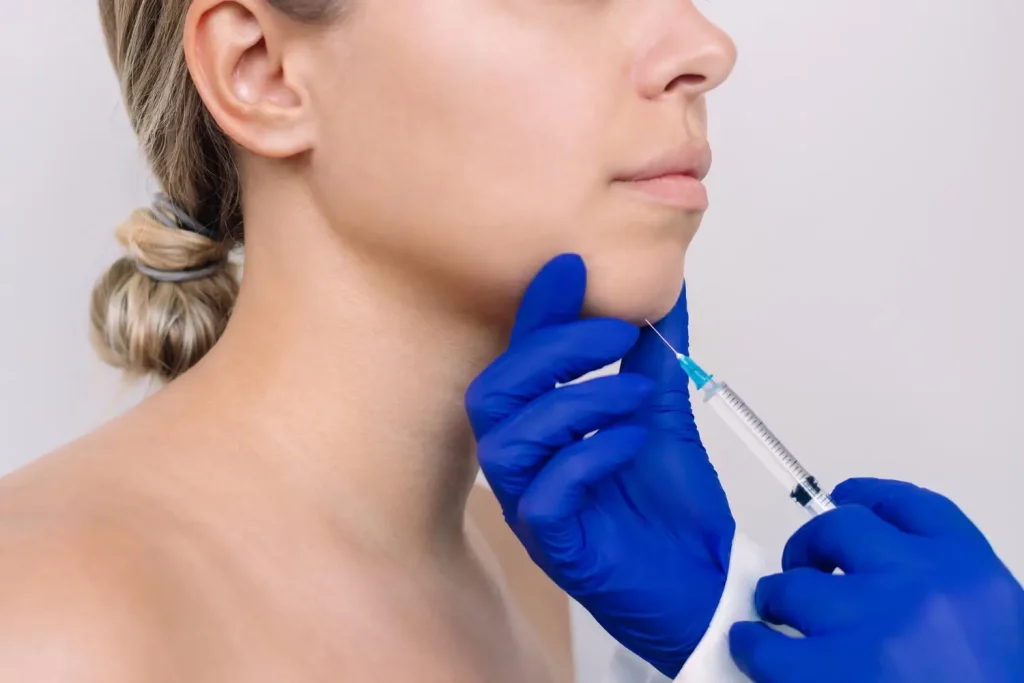Melasma is a type of hyperpigmentation that often affects women, especially during and after pregnancy. It usually appears as large dark patches on the face, although it can also affect other body parts. In this article, we’ll look at the causes of melasma, describe some steps you can take to reduce the appearance of dark spots on your skin, and talk about the role of black light in melasma treatment.
What Is Melasma?
Melasma is a form of hyperpigmentation commonly found on the face, notably affecting the cheeks, nose bridge, forehead, and upper lip, and occasionally appearing on other sun-exposed body areas like the forearms. Melasma can also occur in men but is much more common in women. Melasma is not dangerous but can cause discomfort if it is noticeable.
Understanding the Causes of Melasma
The precise origin of melasma remains uncertain; nevertheless, it stems from excess melanin production, the pigment responsible for skin coloration, by melanocyte cells. Melasma is more common in individuals with a genetic predisposition, those with high exposure to sunlight, women after pregnancy, those with thyroid disease, and those taking hormonal medications such as oral contraceptives.
Studies show that areas of skin with melasma also show signs of skin aging. Thus, melasma can, in a way, be thought of as accelerated skin aging. Cosmetic products, certain cosmetic materials, colognes, perfumes, soaps, and moisturizers can also provoke similar pigmentation spots in melasma-prone individuals after exposure to the sun.
Sunlight is the main factor contributing to and aggravating melasma development. However, other factors such as hereditary predisposition, age, and the use of certain anti-epileptic drugs can also impact the risk of melasma.
Effective Melasma Treatments
Hyperpigmentation in melasma appears slowly and disappears just as gradually with treatment, so doctors and patients should arm themselves with patience. A crucial therapeutic factor is the complete avoidance of sunlight. Moreover, sunscreen cosmetics cannot fully protect the skin, as they usually only block the UVB range, while UVA reaches the skin and worsens the condition. Therefore, it is recommended to wear closed clothing, caps, and hats with wide brims and stay mainly in the shade. This does not reduce the need for UV filters, but patients should remember that they cannot rely on them alone.
Tranexamic acid works in multiple ways: it directly blocks the melanin production in the cells, prevents it from accumulating locally, and disperses the melanin already present in the skin. When it is necessary to affect more deeply buried pigment particles, tranexamic acid is transported into the dermis with the help of liposomal delivery systems.
Azelaic acid can be used in the form of 15% gel or 20% cream. Chemical peels are not out of the question – glycolic acid (50-70%, pH 2.0-3.0), trichloroacetic acid 10-30%, Jessner’s solution (14% lactic acid + 14% salicylic acid + 14% resorcinol), or resorcinol (20-50%) are recommended.
Long-term improvement of refractory melasma has been reported after microneedling, a minimally invasive procedure in which the skin is punctured with short, thin needles, resulting in stimulation of fibroblast proliferation, release of growth factors, and increased collagen production. However, the exact mechanism of the positive effect of this procedure on melasma has not been established.
Different types of hardware cosmetology, such as non-ablative fractional photothermolysis and short-pulse Q-switched Nd:YAG laser are used to treat melasma. The principle of action of fractional lasers is destroying micro parts of the epidermis and dermis to promote their subsequent healing and the formation of healthy skin.
IPL therapy is also actively used to treat melasma. In this case, melanin is the target for exposure to high-intensity pulsed light. This method gives good results in patients with light phototypes.
Important Information
Melasma and age spots are harmless, while melanoma can be life-threatening. If you are concerned about age spots (for example, if they change shape, size, and color, if they itch and bleed), you should consult your doctor.
Types of Melasma
To treat melasma properly, doctors must find out the type of melasma. It manifests in three distinct types, distinguished by the depth of pigment within the skin. Utilizing a Wood’s lamp emitting black light can aid in identifying these variations. The three primary types are:
- Epidermal Melasma:
- Color: Dark Brown
- Border: Well-defined
- Black Light Appearance: Obvious
- Treatment Response: Sometimes responsive
- Dermal Melasma:
- Color: Light brown or bluish
- Border: Blurry
- Black Light Appearance: Unchanged
- Treatment Response: Often unresponsive
- Mixed Melasma:
- Color: Both bluish and brown patches
- Border: Mixed
- Black Light Appearance: Varied pattern
- Treatment Response: Shows partial improvement
Understanding these distinct types is pivotal in tailoring effective melasma treatment strategies and management plans for individuals experiencing this common skin condition.
Black Light in Melasma Diagnosis
In some cases, melasma can be very difficult not only to classify but to detect with the naked eye. However, black light, also known as a UV-A light or Wood’s lamp, has emerged as a valuable instrument in assessing the extent of this skin condition. This tool not only aids in characterizing melasma but also plays a crucial role in educating patients about sun protection practices and potential treatments.
Recent research has shed light on the efficacy of black light in diagnosing melasma. Studies have revealed that hyperpigmentation, a hallmark of melasma, becomes more discernible under black light illumination. The enhanced visibility of these pigmented areas enables doctors to make more accurate and early diagnoses.
The principle behind the black light for melasma, or Wood’s lamp, lies in its ability to detect changes in color that accentuate pigment discoloration and skin disorders. Given that the typically gray and brown patches associated with melasma can be challenging to identify under natural lighting conditions, applying black light provides a critical advantage. This heightened visibility facilitates early black light melasma detection, preventing the condition from remaining unnoticed and potentially worsening over time, especially when exposed to ultraviolet rays or undergoing laser therapy.
Conclusion
Melasma presents a complex challenge for both patients and healthcare professionals. The role of black light, also known as a UV-A or Wood’s lamp, in diagnosing and managing melasma cannot be understated. This valuable tool enhances the visibility of hyperpigmented areas, allowing for more precise melasma diagnosis and tailored treatment strategies. As we’ve discussed, melasma has various causes and treatment options, but early detection is key to effective management. Also, make sure to discuss whether melasma treatments are compatible with cosmetic products like Dysport.
FAQ
What light therapy is best for melasma?
Amongst the known and proven light therapy solutions, the most effective solution for melasma often involves a blend of both Intense Pulsed Light and fractional laser treatments. These approaches, combined together, effectively diminish melasma by targeting and addressing excess pigmentation within the skin. It is essential to consult a dermatologist or medical professional as the first step in determining what is the most suitable treatment plan for your specific situation and concern.
What is the fastest way to cure melasma?
The fastest way to address melasma involves a combination of treatments, including topical hydroquinone, tretinoin, and corticosteroids, along with procedures like chemical peels and laser therapy. However, it’s crucial to consult a dermatologist before treating melasma to get a personalized treatment plan, as results and timelines can vary based on individual factors.
What does melasma look like under black light?
Melasma may appear darker or more pronounced under black light (ultraviolet or UV light) due to the increased melanin content in affected areas. However, the specific appearance can vary among individuals and may not always exhibit a uniform response to UV light. A dermatologist can use a Wood’s lamp or black light to aid in diagnosing and assessing the extent of melasma in a clinical setting.
References
- The International Dermal Institute, Melasma Unmasked by Dr Claudia Aguirre quoting Kang, H. Y., & Ortonne, J. P. (2010). What should be considered in treatment of melasma. Annals of Dermatology, 22(4), 373–378.
- Trivedi MK, Yang FC, Cho BK. A review of laser and light therapy in melasma. Int J Womens Dermatol. 2017;3(1):11-20. Published 2017 Mar 21. doi:10.1016/j.ijwd.2017.01.004
- Piętowska Z, Nowicka D, Szepietowski JC. Understanding Melasma-How Can Pharmacology and Cosmetology Procedures and Prevention Help to Achieve Optimal Treatment Results? A Narrative Review. Int J Environ Res Public Health. 2022;19(19):12084. Published 2022 Sep 24. doi:10.3390/ijerph191912084
- Cassiano DP, Espósito ACC, da Silva CN, et al. Update on Melasma-Part II: Treatment. Dermatol Ther (Heidelb). 2022;12(9):1989-2012. doi:10.1007/s13555-022-00780-4
- González-Molina V, Martí-Pineda A, González N. Topical Treatments for Melasma and Their Mechanism of Action. J Clin Aesthet Dermatol. 2022;15(5):19-28.
- Dayal S, Sahu P, Yadav M, Jain VK. Clinical Efficacy and Safety on Combining 20% Trichloroacetic Acid Peel with Topical 5% Ascorbic Acid for Melasma. J Clin Diagn Res. 2017;11(9):WC08-WC11. doi:10.7860/JCDR/2017/26078.10685



















